Morgan's Musings
Tuesday, November 26th, 2002 - 5:10 PM
Project on Kente Cloth

Justin P. Morgan's Art History II (221)
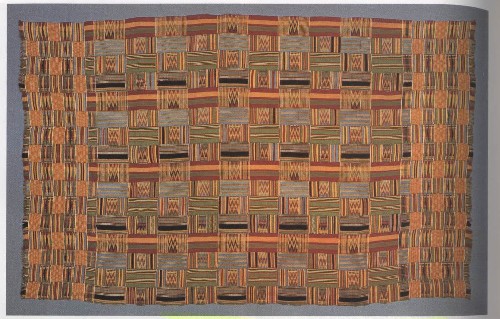
Introduction...
Unlike many of the other projects, kente cloth is not a specific work, but a genre of sorts of artwork. Within it, there are many unique and intricate styles that represent different events & social standings. Kente Cloth's rich history and the unique culture that weaves its diverse styles had many uses in the past, and is still seen presently.
History...
Weaving had been done in Africa since 3000 B.C.E. Weavers from Sudan brought looms to the Akan peoples of Ghana and Cote d'Ivoire, specifically the Asante (Ashanti) tribe and to a lesser extent the Ewe people. Legends say that weavers in the town of Bonwire in Ghana observed how a spider wove its web, and tried to emulate it with raffia fibers. Raffia fibers, also used to make kuba, gave the fabric a basket woven look, so they called it "Kente", an offshoot of the word "Kenten Ntoma", literally meaning "basket cloth" in Twi, the Asante language. It was also referred to as "Nsaduaso" or "Nwontoma", which means "cloth hand woven on a loom". These two terms are still used by Asante elders and weavers to this day.
Weaving...
The looms are small, horizontal, lightweight treadle looms that weave long, narrow strips of kente cloth 4 inches wide. Originally, the threads used were silk unraveled from Chinese textiles given to the Asante by European traders. Now, its much more common for the raw material to be rayon, cotton, fabric blends and occasinally even metallic threads.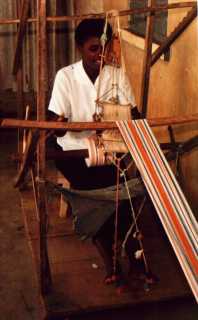 Men traditionally do this work, by first laying out long warp threads into a colorful style, then weaving weft threads through warp threads to create the patterns The long strips this process produces are sewn together to make a blanket of kente cloth.
Men traditionally do this work, by first laying out long warp threads into a colorful style, then weaving weft threads through warp threads to create the patterns The long strips this process produces are sewn together to make a blanket of kente cloth.
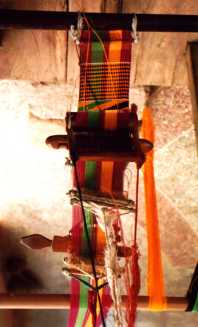
Styles...
In a wide variety of styles and colors, these physical attributes of kente cloth are symbolic of a wide variety of things. First, let's discuss a few of the many styles:
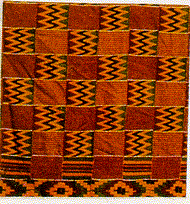 Sika Futoro=="Gold dust"--Gold dust was used as currency between Akan tribes, and it is represented in this pattern. It also symbolizes wealth, royalty, elegance, honorable acheivements & spiritual purity.
Sika Futoro=="Gold dust"--Gold dust was used as currency between Akan tribes, and it is represented in this pattern. It also symbolizes wealth, royalty, elegance, honorable acheivements & spiritual purity.
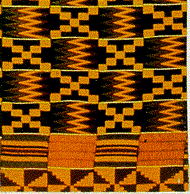
Obaako Fu Mmu Man=="One person does not rule a nation"--Participatory democracy was/is a valued concept to the Akan people. The pattern of nine squares symbolizes the nine hair-tuft hairstyle of Asante royal functionaries. This style also symbolizes participatory democracy and warns against autocratic rule.
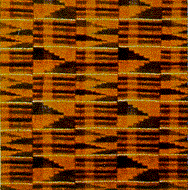 Adwinasa=="All motifs are used up"--This was an attempt to create a new cloth design using all the known motifs at the time. It symbolizes wealth, royalty, elegance, superior craftsmanship, excellence, creative ingenuity, and perfection.
Adwinasa=="All motifs are used up"--This was an attempt to create a new cloth design using all the known motifs at the time. It symbolizes wealth, royalty, elegance, superior craftsmanship, excellence, creative ingenuity, and perfection.
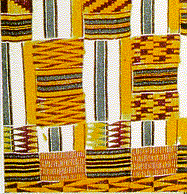 Toku Kra Toma=="Toku's soul cloth"--Created to commemorate the corageous soul of a warrior Queenmother, defeated and killed during the early 16th-century as she battled against an Asante king. It symbolizes corageous leadership, heroic deeds, self-sacrifice, rebirth and spiritual vitality as well.
Toku Kra Toma=="Toku's soul cloth"--Created to commemorate the corageous soul of a warrior Queenmother, defeated and killed during the early 16th-century as she battled against an Asante king. It symbolizes corageous leadership, heroic deeds, self-sacrifice, rebirth and spiritual vitality as well.
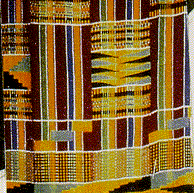 Nyankonton=="God's eye brow or The rainbow"--In admiration of beautiful rainbows seen across the skies, the arrangement of this pattern's warp threads were made to emulate how rainbows are perceived by the human eye. Within this, it symbolizes divine beauty & creativity, gracefullness, uniqueness, and a general good omen.
Nyankonton=="God's eye brow or The rainbow"--In admiration of beautiful rainbows seen across the skies, the arrangement of this pattern's warp threads were made to emulate how rainbows are perceived by the human eye. Within this, it symbolizes divine beauty & creativity, gracefullness, uniqueness, and a general good omen.
Now, commonly used colors and their significance:
Red--Signifies blood, sacrifice, struggle, and sometimes a serious social or political mood.
Yellow--Identifies with the edible (egg yolks, fruits and vegetables), and the inedible, namely gold. It symbolizes royalty, wealth, spirituality and fertiltiy as well.
Black--A very spiritual color to the Asante, they believed items darkened with age had increased religious potency. Black within kente cloth symbolizes that, as well as spiritual maturity, energy, antiquity, and respect to their ancestors.
Pink--Representing the female essence of life, it symbolizes the mild & gentle, the tender, pleasant, calm and sweet.
Blue--The sky in cloth form, of course! As well as God, blue also symbolizes harmony, love, peace and good luck.
Green--Nature and vegetation. It also symbolizes planting, harvesting, fertility, prosperity, fruitfulness, and health both physically and spiritually.
White--Associated with egg whites and clay used in religious rites and festivals, it symbolizes contact with apparitions, and in conjunction with other colors, vitality and balance.
Uses...
Kente Cloth was originally used for state regalia and for special social (like rites of passage, child naming and ancestrial rememberance ceremonies) and religious functions (like burial ceremonies, soul-cleansing, and marraige) as well. The tribe's chief would have strict control over kente patterns, reserving some for exclusive use. Commoners who wore patterns reserved for royalty were punished, and reserved patterns could not be sold by weavers in village markets.
Men would wear one huge piece, like a toga, that was 6 to 7 ft. long by 12 to 13 ft. wide. Traditionally, they'd chose patterns with dark colors like maroon, black, dark blue, and dark green. Women wore a two-piece skirt and shaw set, and would wear colors light colors tinted light blue, light yellow, pink, purple, and light yellow.
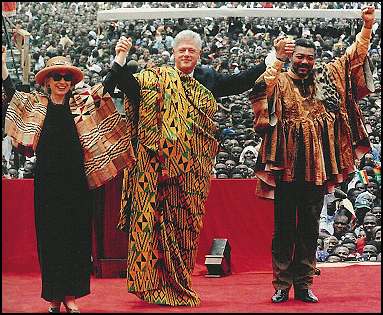
Nowadays, anyone can wear kente, and it is applied in various ways. Ties, dresses, shirts, pants, sweaters, belts, skirts, cumberbuns, graduation wear, scarves, rugs and tapestries are among some of the uses of the textile cloth. The patterns, often printed on cloth in factories, can be used in sundry ways--from wallpaper to stationary.
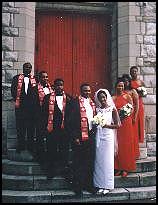
Conclusion...
Kente cloth is a textile woven into the fabric of African culture. Its symbolic, yet geometric patterns are works of art that have appealed throughout the centuries, despite cultural changes and cloth significance. Although the materials and methods of making kente have changed throughout the years, there are still weavers who continue to use the traditional movements. Kente is the cloth that binds Asante civilization together.
+*+*+*+*+*
Sources
*+*+*+*+*+
Stokstad, Marilyn. Art History, Second Edition. Volume 2. 2002, Prentice Hall, Inc. , NJ
World Book Encyclopedia, 2001 edition. "Kente Cloth".
More images of kente cloth here.
+*+*+*+*+*
Hey, Art History 221 Students! Look Here!
Now while you're here, feel free to to browse some of my older entries by clicking the link at the top left of this page or click the links below to hear my say about our art history class (and our professor)...
Read about a Papa New Guinea Tubuan
What some of my classmates do Thursday evenings
A good description of our class
A little bit more about our class
*+*+*+Enjoy! Thanks for reading!+*+*+*
�
Previous -*- Next -*- Top Floor -*- Ring-a-Ding-ding Rings
�

![[Blue Ribbon Campaign icon]](https://br.eff.org/br.gif) Join the Blue Ribbon Online Free Speech Campaign!
Join the Blue Ribbon Online Free Speech Campaign!